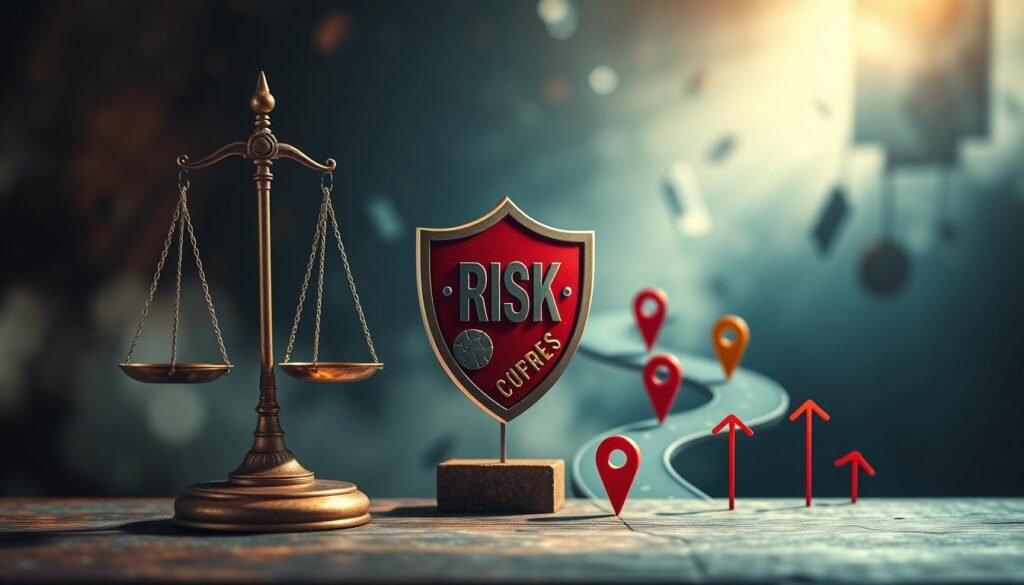Business Plan a successful business means dealing with many risks. These risks can be physical, human, or technological. By tackling these risks early, you can make your business stable and growing for the long term.
Good business risk management means looking at risks, planning for them, and taking steps to lessen their impact. With risk assessment, contingency planning, and smart risk mitigation strategies, your business can bounce back stronger from tough times.
This article will cover the different risks businesses face, why planning for risks is key, and how to protect your company’s future. By knowing and tackling these important points, you can confidently face the business world and keep your business thriving.
Table of Contents
Types of Risks Business Plan Face
Businesses must be proactive in identifying and managing risks to protect their operations and ensure long-term success. These risks include physical, location-based, human, and technological risks.
Physical Risks
Physical risks include threats like building fires, explosions, and spills of hazardous materials. To handle these physical business risks, it’s important to train employees on emergency procedures. Also, having safety gear like fire alarms and sprinklers is crucial. And, having plans ready for after an incident is key.
Location Risks
A business’s location can also bring risks, such as nearby fires, storm damage, floods, earthquakes, and other natural disasters. To tackle these, employees should know evacuation routes. Also, having liability or property insurance can help cover the costs of these risks.
By tackling these risks head-on, businesses can become more resilient. This helps them grow and last over the long term.
“Effective risk management is essential for businesses to navigate challenges and make informed decisions that drive sustainable growth.”
Human and Technological Risks
As a business owner, knowing about human resource risks and technological risks is key. These risks include employee misconduct and technology failures. It’s important to have plans to lessen their effects.
Human risks like alcohol and drug abuse, embezzlement, theft, fraud, and employee illness or injury can hurt your team. To fight these, use employee assistance programs, do background checks, and have backup personnel ready.
Technological risks, such as power outages, computer failures, and cloud storage issues, are big problems too. To beat these, invest in backup generators, surge protectors, and strong data backup systems. This keeps your business safe from technology failures and protects your data.
| Risk Category | Potential Impacts | Mitigation Strategies |
|---|---|---|
| Human Resource Risks |
|
|
| Technological Risks |
|
|
Handling both human resource risks and technological risks makes your business stronger. It helps keep your operations safe from problems.

“Proactive risk management is the key to ensuring the long-term success and stability of any business.”
Business Risk Management
Effective business risk management is key for companies to handle potential threats. It means identifying, assessing, and tackling risks to make companies stronger and help them reach their goals.
Risk assessment is a big part of this. It looks at how likely and big risks are, helping companies focus and use their resources well. This way, companies can spot big threats and make plans to deal with them.
Some common risk management strategies include:
- Risk Avoidance: Getting rid of or avoiding risky activities or situations.
- Risk Retention: Taking on and managing risks that the company can handle financially.
- Risk Transfer: Passing on risks to others, like through insurance or outsourcing.
- Risk Mitigation: Lowering the chance or effect of risks.
- Risk Diversification: Spreading risks across different areas or units.
By using a full risk management plan, companies can tackle threats and find new chances for growth and efficiency. With data analysis, contingency planning, and employee education, they can be proactive and adapt to risks, making them more resilient and competitive.
| Risk Management Strategies | Description |
|---|---|
| Avoidance | Getting rid of or avoiding risky activities or situations. |
| Retention | Taking on and managing risks that fit the company’s control and budget. |
| Transfer | Making others responsible for risks, like through insurance or outsourcing. |
| Mitigation | Reducing risks’ chances or effects with specific actions. |
| Diversification | Spreading risks over different areas or units. |
By using strategic risk management, companies can guard against threats and find new chances for growth and success. A proactive and detailed approach helps them face modern business challenges and aim for long-term success and wealth.

“Effective risk management is not about avoiding or eliminating risks, but about understanding and managing them to achieve organizational objectives.”
Making a Risk Assessment
For businesses, assessing risks is key to keeping operations safe. After spotting the risks, it’s important to sort them by how likely they are to happen. This is done using a probability scale.
Establishing a Probability Scale
Setting up a probability scale helps manage risks well. This scale has labels like “very likely to occur” and “very little chance of occurring.” This way, companies know how likely each risk is and can plan better.
Using Actuarial Data
Actuarial tables give stats on risk likelihood and financial impact. These actuarial data help businesses see which risks are most serious. They guide in making plans to tackle the biggest threats.
Using a probability scale and actuarial data helps make a solid risk assessment process. This approach helps companies make smart choices and reduce risks effectively.
| Risk Category | Probability Scale | Actuarial Data | Potential Impact |
|---|---|---|---|
| Compliance Risks | Some chance of occurring | 20% likelihood, $50,000 average cost | Regulatory fines, legal fees, reputational damage |
| Cybersecurity Risks | Small chance of occurring | 10% likelihood, $100,000 average cost | Data breaches, system downtime, loss of customer trust |
| Supply Chain Disruptions | Very likely to occur | 80% likelihood, $75,000 average cost | Production delays, revenue loss, customer churn |
By using a probability scale and actuarial data, companies can make a detailed risk assessment process. This helps them focus on the biggest threats, keeping their operations safe.

Insuring Against Risks
Keeping your business safe from risks is key to doing well over time. Business insurance is a vital tool for handling financial risks and keeping your business running smoothly. It covers everything from fire damage to product liability.
When figuring out what insurance you need, don’t just think about the best-case scenario. Plan for the worst-case scenarios that could hit your business hard. Your insurance should match the unique risks and needs of your company. This means considering things like what you do, who works for you, and how you use technology and data.
Here are some key insurance policies to think about:
- Fire insurance to cover losses from fires
- Product liability coverage to protect against claims about faulty products
- Fraud/embezzlement protection to lessen the risk of financial crimes inside the company
It’s important to check and update your insurance regularly as your business changes. With the right business insurance, you can manage risks and focus on growing your business with less worry.
| Insurance Type | Description | Benefit |
|---|---|---|
| Fire insurance | Protects against financial losses due to fire-related incidents | Helps cover the cost of property damage and business interruption |
| Product liability coverage | Covers claims related to faulty or defective products | Safeguards your business from potential lawsuits and financial liability |
| Fraud/embezzlement protection | Mitigates the risks of internal financial crimes | Provides financial protection against losses due to employee theft or fraud |

“Protecting your business from potential risks is essential for long-term success.”
Conclusion
Effective risk management best practices are key for dealing with uncertainty and achieving long-term success in business. By using strategies like risk avoidance, reduction, and transfer, you can protect your assets and keep your business stable. Regular risk assessments and strategic insurance use help build a strong, adaptable business ready for challenges and opportunities.
It’s important to keep checking and adjusting your risk management plans. This ensures your business stays ready for new threats and is set for growth. By focusing on resilience and adaptability, you can move through the changing business world with confidence and secure your future.
Creating a detailed risk management plan is vital for protecting your business and helping it grow sustainably. By being vigilant, proactive, and flexible, you can overcome challenges and uncertainties. This strengthens your competitive edge and ensures your business thrives.



